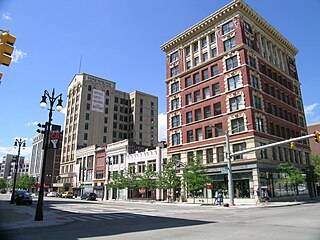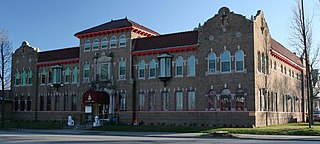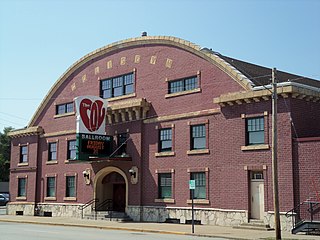
Waumandee is a town in Buffalo County in the U.S. state of Wisconsin. The population was 472 at the 2010 census. The census-designated place of Waumandee is located in the town. The ghost town that was Anchorage is located in the town.

Turner Hall is a historic athletic club facility at 1034 North 4th Street in Milwaukee, Wisconsin. Named using the German "Turnen", meaning gymnastics or physical fitness, it is significant for its association with the American Turners, a German-American athletic, cultural, and political association. The Milwaukee group was founded in 1853 under the title, "Socialist Turnverein"; its leaders included Socialist Congressman Victor Berger. The building is one of the largest and most distinctive surviving buildings associated with the Turner movement, and was designated a National Historic Landmark in 1996. It is now used as a performance and meeting venue.

The Harmonie Club is a club located at 267 East Grand River Avenue in Downtown Detroit, Michigan. It was designated a Michigan State Historic Site in 1975 and listed on the National Register of Historic Places in 1980.

The Broadway Avenue Historic District is a historic district located on a single city block along Broadway Avenue between Gratiot and East Grand River in downtown Detroit, Michigan. It was listed on the National Register of Historic Places in 2004. The Broadway Avenue Historic District joins the Randolph Street Commercial Buildings Historic District, a rare surviving commercial area which dates from the 1840s.

Star Theatre, also known as Partridge Hall, is a shop/meeting hall/theater built in 1878 in Argyle, Wisconsin, in Lafayette County, Wisconsin, United States. It was listed on the National Register of Historic Places in 1980.

The Fletcher Union Church, also known as the Fletcher Community House, is a historic former church building on TH 1 in Fletcher, Vermont. Built in 1871, it is one of only a few public buildings in the small community, and has for over a century been a secular community meeting space. It was listed on the National Register of Historic Places in 1982.

The Pythian Castle Lodge, also known as Crystal Palace, in Milwaukee, Wisconsin, United States, was built in 1927 by the Knights of Pythias, a fraternal organization. In 1988 it was listed on the National Register of Historic Places.

La Prairie Grange Hall No. 79, also known as the La Prairie Town Hall, is a historic two-story wooden Grange hall built in 1874 in La Prairie, Rock County, Wisconsin. One of the oldest remaining Grange halls in the U.S., it was listed on the National Register of Historic Places in 1977.

The Col Ballroom is a historic building located in the West End of Davenport, Iowa, United States. It was listed on the National Register of Historic Places and on the Davenport Register of Historic Properties as the Saengerfest Halle.

Castolon, also known as La Harmonia Ranch and Campo Santa Helena, was a small community in southwestern Texas, United States, located in what is now Big Bend National Park along the Rio Grande. The location was first settled in 1901 by Cipriano Hernandez, who farmed the area and built the original Castolon Store, now known as the Alvino House.

Glenside Memorial Hall often abbreviated "Glenside Hall" is a historic meeting hall located in the Philadelphia suburb of Glenside, Cheltenham Township, Montgomery County, Pennsylvania. Glenside Hall was built in 1926, and is a 2+1⁄2-story, T-shaped, red-brick Colonial Revival-style building with limestone trim. It sits on a raised stone foundation and has a slate-covered gable roof. It was to honor the veterans of World War I. Today, it is used primarily for banquets, meetings, and other social events.

The New Glarus Town Hall in New Glarus, Wisconsin, was built in 1886 to house both the town hall and a meeting place for the Ancient Order of United Workmen. It was added to the National Register of Historic Places in 2008.

The Prairie du Chien City Hall is the city of Prairie du Chien, Wisconsin's historic former city hall. It was built in 1894 on the grounds of the city's former opera house, which burned down the previous year. In addition to being the center of city government, the building held a civic auditorium, Prairie du Chien's first public library, a jail, and the city's police and fire departments. From 1929 to the 1950s, the American Legion held meetings and events there as well. In 2002–03, the city government moved to a new city hall.

Carl F. Struck was a Norwegian American architect, who designed private residences, civic buildings and commercial structures throughout the Midwest in the latter part of the 19th century.

Jones Hall, also known as The Meetinghouse at Marlow Hill or The Christian Church, is a historic church and municipal building on Church Street in Marlow, New Hampshire. Built between 1792 and 1800, it is a rare 18th-century meeting house in New Hampshire, although it has been altered somewhat and moved from its original location; it was said to originally be a near duplicate of the Rockingham Meeting House in Vermont. Construction of the timber frame building was repeatedly delayed due to a shortage of funding. It first served as a combined religious and civic meeting house, with ownership residing with the society of pew owners.

The Kensington Town House is the town hall of Kensington, New Hampshire. Located at 95 Amesbury Road, the single-story wood-frame building was erected in 1846, and has been its only purpose-built municipal hall. It is a good local example of civic Greek Revival architecture, and its hall has historically hosted town meetings and social functions. The building was listed on the National Register of Historic Places in 2013.

Stevens Memorial Hall is the historic town hall of Chester, New Hampshire. The building, a large wood-frame structure completed in 1910, is located in the center of Chester at the junction of New Hampshire Routes 121 and 102. The building was listed on the National Register of Historic Places in 2004. It served as the center of the town's civic business until 2000, when town offices were relocated to a former school.

Bristol Town Hall, at 45 Summer Street, is the town hall of Bristol, New Hampshire. It is a single story Greek Revival structure, built in 1849, and was the town's first purpose-built town hall. It continues to serve as a municipal meeting and polling place, although town offices are now in a modern building on Lake Street. The building was listed on the National Register of Historic Places in 2015.

The Ripton Community House, formerly the Ripton Congregational Church, is a historic former church and present community hall on Vermont Route 125 in the village of Ripton, Vermont. Built in 1864 for a Congregationalist church, it has since served as a community clubhouse and town-owned meeting hall, and is a fine local example of vernacular Greek Revival architecture. It was listed on the National Register of Historic Places in 1973.

The Richland Center City Auditorium is a three-story red brick public auditorium in Richland Center, Wisconsin. It was built in 1912 as a combination city hall, theatre, and clubhouse. The building was listed on the National Register of Historic Places in 1980 for its significance in local social and political history. It was also listed as a contributing structure to the Court Street Commercial Historic District in 1989. The auditorium currently houses the Richland County Performing Arts Center.






















